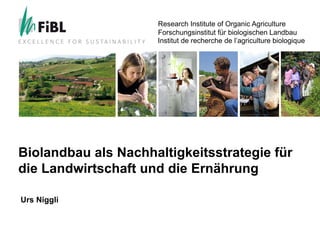
Prof. Dr. Urs Niggli - Rolle des Bio-Landbaus in der Schweiz und international
- 1. Research Institute of Organic Agriculture Forschungsinstitut für biologischen Landbau Institut de recherche de l’agriculture biologique Biolandbau als Nachhaltigkeitsstrategie für die Landwirtschaft und die Ernährung Urs Niggli
- 2. Um was geht es im Vortrag? Wie kräftig ist der Bio-Trend und wohin führt er? Was sind die Stärken der biologischen Landwirtschaft? Kann der Biolandbau die Welt ernähren?. Schlussfolgerungen. www.fibl.org
- 3. Development of organic agricultural land world-wide, 1999-2010 40 = 0.9 % 37.1 37.0 35 35.2 32.3 30 30.1 29.7 29.0 Million hectares 25 25.7 20 19.8 17.2 15 14.9 10 11.0 5 0 1999 2000 2001 2002 2003 2004 2005 2006 2007 2008 2009 2010 www.fibl.org Source: FiBL & IFOAM, 2012
- 4. Europe: Development of organic agricultural land Europa: 2.1 % 15.0 EU: 5.1 % Million Hectares AT: 20 % 12.0 10.00 9.20 8.27 9.0 7.77 7.27 6.76 6.35 6.21 5.81 5.43 6.0 4.46 3.0 0.0 2000 2001 2002 2003 2004 2005 2006 2007 2008 2009 2010 www.fibl.org Source: FiBL & IFOAM, 2012
- 5. Switzerland: Development of organic agricultural land 1990-2010 150'000.0 = 11.5 % 125'000.0 119'613.02 117'800.00 117'116.00 116'641.00 116'266.37 114'561.23 114'050.46 109'090.14 100'000.0 102'642.11 93'955.00 Hektaren 82'737.22 75'000.0 79'268.73 71'538.92 64'462.79 59'400.00 50'000.0 20'800.00 34'200.00 10'000.00 26'100.00 12'300.00 17'300.00 25'000.0 0.0 199019911992199319941995199619971998199920002001200220032004200520062007200820092010 www.fibl.org Source: FiBL & IFOAM, 2012
- 6. Development of the global market for organic food and beverages 70 Revenues in billion US Dollars 60 50 40 Ø annual growth 30 rate 2000-2010: 54.9 59.0 23 % 20 40.2 25.5 10 17.9 0 2000 2003 2006 2009 2010 Source: Organic Monitor (Sahota 2011) www.fibl.org
- 7. Per capita consumption of certified organic food (top 10) Switzerland 153 Denmark 142 Luxembourg 127 Austria 118 Liechtenstein 100 Sweden 86 Germany 72 United States of America 65 Canada 57 France 52 0 50 100 150 200 Per capita consumption 2010 www.fibl.org Source: FiBL & IFOAM, 2012
- 8. Was sind die Stärken des Biolandbaus? Ökologisch vorzüglich. } Hohe Effizienz (produktive Low-Input-Strategie). Beispiele Sehr vorsichtig mit Risiken (neue Technologien, ‘Natürlichkeit’, ‘nicht industriell’). ‘Vorsorge’ und ‘Vermeidung’ als grundlegendes Prinzip. Aktive Auseinandersetzung mit ethischen und sozialen Fragestellungen (Tierwohl, bäuerliche Landwirtschaft, Arbeitsbedingungen). Umfassender, ganzheitlicher Ansatz für eine nachhaltige Landwirtschaft und Ernährung. www.fibl.org
- 9. Wissenschaftliche Beurteilung des Effekts von Bio auf die Biodiversität (< 200 Publikationen). 30 % höhere Artenvielfalt und 50 % mehr Individuen von Gliederfüsslern (Insekten, Spinnen, Käfer …) in Biofeldern, hauptsächlich Räuber und Parasitoide. Bio fördert Befruchter: Hausbiene, Wildbiene, Schmetterlinge, Hummeln sowie andere Insekten und Fledermäuse. Böden: Regenwürmer, Bodeninsekten, Bakterien, Pilze und Mykorrhizen stark erhöht. Vögel: Deutlich mehr natürliche Zuchtgebiete, höhere Populationendichte und mehr Aufzucht. Höhere Vielfalt and Segetalflora im Ackerbau. www.fibl.org Hole et al., 2005; Niggli, 2010
- 10. Mehr Humus = Kohlenstoffspeicher im Bioacker 74 Langzeit- Feldexperimente, weltweit www.fibl.org Gattinger et al. 2012
- 11. Resource use efficiency (DOK trial, 28 years) Parameter Unit Organic Integrated Organic farming farming (IP) in % with FYM of IP Nutrient input kg Ntotal ha-1 yr-1 101 157 64 % kg Nmin ha-1 yr-1 34 112 30 % kg P ha-1 yr-1 25 40 62 % kg K ha-1 yr-1 162 254 64 % Pesticides applied kg ha-1 yr-1 1.5 42 4% Fuel use L ha-1 yr-1 808 924 87 % Total yield output for 28 years % 83 100 83 % Soil microbial biomass „output“ tons ha-1 40 24 167 % www.fibl.org Mäder, Fliessbach, Niggli (2002), Science 296
- 12. Peak Oil: Die Alternative heisst gemischter Betrieb und Klee (die beiden Charakteristika von Bio) Viehbestand: 21.7 Milliarden Köpfe (1.5 Milliarden Rinder und Büffel) (Steinfeld et al., 2006). 160 Millionen Tonnen Stickstoff ausgeschieden: › 34 Millionen (Steinfeld et al., 2006) als Dünger wieder ausgebracht (ungleichgewichtig auf Grünland). › Rest: Rückstände auf Weiden, Heizmaterial oder als Abfall deponiert. 140 Millionen Tonnen von Stickstoff aus Leguminosen in nachhaltigen, den Boden verbessernden Fruchtfolgen (Badgley et al., 2008). 90 Million Tonnen Stickstoff aus Erdöl hergestellt (Steinfeld et al., 2006). www.fibl.org
- 13. ‘Eat the landscape’ www.fibl.org
- 14. Kann der Biolandbau die Welt ernähren? Wir produzieren schon viel zu viel. ® Conventional agriculture “simply is not the best choice anymore today. A large segment of the scientific community now acknowledges the positive impacts of agro-ecology on food production, poverty alleviation and climate change mitigation – and this is what is needed in a world of limited resources.” UN Special Rapporteur on the right to food Olivier De Schutter * * The report “Agro-ecology and the right to food” is available at www.fibl.org http://www2.ohchr.org/english/issues/food/docs/A-HRC-16-49.pdf
- 15. Bio ist produktiv: Studien aus Entwicklungsländern Umstellung auf Biolandbau bringt im tropischen Afrika eher höhere Erträge als Ertragsausfälle (Gibbon and Bolwig, 2007). Mittlere Ertragssteigerung in 114 Projekten in Afrika (2 Millio- nen Hektaren, 1.9 Millionen Menschen): 116 % (Pretty et al., 2008, UNEP/UNCTAD). Ertragssteigerung von 80 % in 133 pflanzlichen und tierischen Produkten in Feldversuchen und Betriebsvergleichen in Entwicklungsländern (Badgley et al., 2008). www.fibl.org
- 16. Verfehlte Landnutzung Produktiv Konventionelle Landwirtschaft Ökologische Landwirtschaft Deutlich höhere Ökosystem- leistungen Getreide als Viehfutter (15 – 20 %) Unproduktiv Energiepflanzen (0 %) “Please eat less meat. Meat is a very carbon intensive commodity.” Rajendra Pachauri Chair IPPC, Nobel Laureate 2007 www.fibl.org
- 17. Biologische Ernährung ist auch für Menschen in Entwicklungsländern erschwinglich: Group Certification und Participatory Guarantee Systems (PGS) www.fibl.org
- 18. Zusammenfassung Biolandbau ist ein umfassender, ganzheitlicher Ansatz für eine nachhaltige Landwirtschaft und Ernährung. Biolandbau ist eine produktive, agrar-ökologische Produktionsweise. Die Innovation geht konsequent über Prävention und ganzheitliche Lösungen. Für Kleinbauern ist er eine gute Strategie, um Erträge und Einkommen zu steigern. Die Zukunft könnte eine Anbauweise sein, welche den Biolandbau von heute als Basis nimmt, und gezielt moderne Technologien integriert, welche ihren Zielen dient. www.fibl.org
